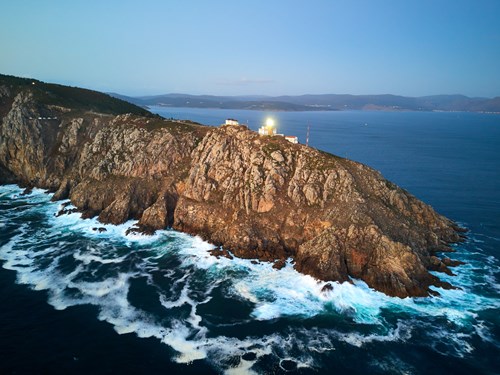
Day Five
"All well.
08.00 - Noon. The generators run for 3-4 hours and the pumps and electrics are tested
12.00 Noon. We have reached 44° 55'N; 08 40'W and are progressing steadily northwards.
We all eat together out on deck as there is no saloon! The menu is varied and usually concocted by Charlie who has assumed the role of Cook. The bread is still fresh.
17.00 hrs This is Happy Hour when I, Murray and Charlie enjoy a rum and Coke with a slice of lime which is well known in sailing circles to keep scurvy at bay.
Weather is rather overcast and dull.
The day ended slightly hazy but we have now passed Cape Finisterre and we are crossing the Bay of Biscay. There is a fair amount of shipping about. "
Cape Finisterre is a rock-bound peninsula on the west coast of Galicia, and, in Roman times it was believed to be the end of the known world: the name Finisterre is from the Latin finis terrae, meaning "end of the earth". It is one of the places in Europe where the very last rays of the setting sun may be seen. The coast is dangerous and rocky: known locally as the Costa da Morte, or the coast of Death, and is where numerous ships have foundered or wrecked.
Galatea and Wallasey are now in the UK Shipping Forecast Area named after this peninsula, until altered in 2002 to Fitzroy after the founder of the UK Meteorological Office.
"23.59 hrs. All is well, including the tow. The wind remains NE'ly and reducing from Force 4/5 to 2."
This point in the return voyage marks the start of the ship's passage across the Bay of Biscay, an area of sea renowned for some savage storms - or balmy calms, depending on the luck of the mariner!
While the average depth is 1,744 metres (5722 ft.), the greatest depth is 4,735 etres (15,535 ft.) where ships may be lost without trace. Over the north-eastern section, the continental shelf extends for out, into the Bay, determining relatively shallow waters which stimulate the rough seas for which the region is renowned and feared.
It is said that the Bay of Biscay is home to some of the Atlantic Ocean's fiercest weather and some exceedingly big waves occur there. It was a regular occurrence for merchant vessels to founder in Biscay storms, especially in the winter months.
The logbook of Captain Alistair Miller
Additional text by Elizabeth Allen
Image - Deensel, CC BY 2.0 via Wikimedia Commons